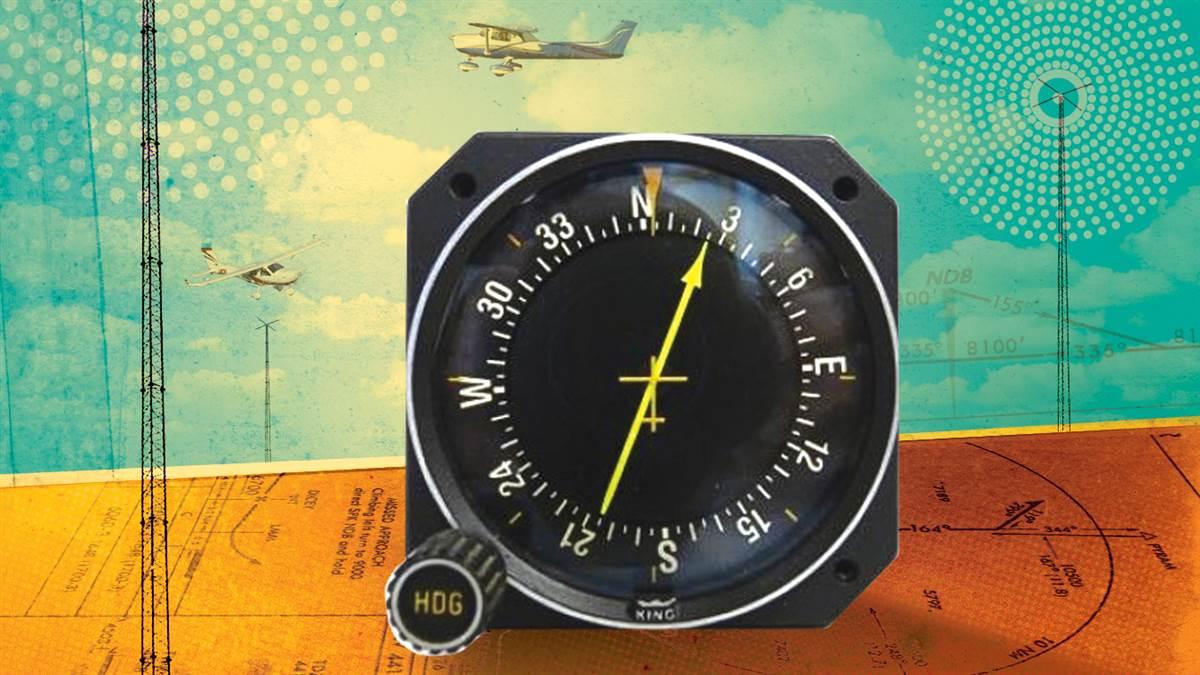On Instruments: NDBs, gone? Not really
NDBs are rare, but still part of a well-rounded pilot’s training

All this doesn’t help should you someday fly in places such as Canada, Europe, and other destinations far from your home field. Those are the times you’ll wish you had ADF tracking and NDB approach proficiency.
Proficiency in NDB approaches and tracking procedures takes a lot of time and practice, and there’s certainly not enough space here to do a comprehensive review. But we can do a truncated overview of three basic maneuvers: homing to an NDB, tracking a bearing to an NDB, and tracking a bearing away from an NDB.
Homing
This is easy. Let’s say you want to go right over an NDB station, flying directly to it on no particular bearing. (NDBs don’t generate radials like VORs; they put out a single signal that emanates in all directions.) To do this, you’d turn the airplane until the ADF needle is aimed straight ahead. Now, the job is to keep the needle in that position.
In a no-wind situation, your heading would remain the same, and the ADF needle wouldn’t move. The problem is, there’s usually a crosswind component at work, so maintaining a constant heading means that the ADF needle drifts away from straight-ahead. With homing, this isn’t an issue. You turn the airplane so the ADF needle is once more pointing at 12 o’clock, and you keep flying toward the station.
This works, but it’s not very precise. Turning to keep the needle on the nose produces a curved flight path. When shooting NDB approaches, you want to correct your heading so that you track a straight line corresponding to a specific bearing.
Tracking to an NDB
Let’s say you’re flying an approach defined by a bearing that leads you to an NDB located on an airport. This is when you can’t simply home to an NDB; you have to adjust your heading so that you crab into the wind and track the published course. How much of a crab angle will you need? For that, you’ll need to intercept the published bearing inbound, then watch the ADF needle’s direction and amount of movement.
Hopefully, your own situational awareness, perhaps aided by a controller’s vectors, will have put you reasonably close to the NDB’s reception range, properly oriented with regard to your position relative to the NDB, and this position has you within 45 degrees of the final approach course.


You can begin intercepting by turning to the heading corresponding to that of the inbound course—let’s say 340 degrees—and noting the ADF needle’s deflection. Now you’re paralleling the inbound course, and you see the ADF needle 20 degrees to the right of your heading. To intercept the course, you’ll needle to double that 20-degree angle by turning 40 degrees to the right. As you turn right, the ADF needle turns left, and when it reaches 40 degrees to the left you’ll have intercepted the inbound course. Now turn to the left until your heading indicator reads 340 degrees and continue tracking inbound. If the ADF needle moves five degrees to the left, for example, turn 10 degrees to the left; when the needle is 10 degrees to the right, roll the 10 degrees out and continue tracking—but with a wind correction angle that puts the ADF needle, say, at a relative bearing of five degrees to the right of your new inbound heading. As you get closer to the station, the ADF needle becomes more sensitive, so corrections may be required more often.
Having a radio magnetic indicator or a manually rotatable ADF card helps visualization greatly. With these instruments, you can see the ADF needle superimposed on your current heading, sparing you the mental gymnastics of scanning and comparing two different, changing values on two different, non-collocated instruments.
Tracking away from an NDB
This procedure is similar, but in this case the ADF needle is pointing aft. As with tracking to an NDB, intercept angles are double the angle of needle deflection, but interception of the desired course occurs when the ADF needle registers a relative bearing equal to the reciprocal of the outbound heading, give or take a few degrees for a wind correction angle.
There’s plenty of advice concerning NDB approaches and tracking, most of it helpful. Needle right? Turn right to intercept. Needle left? Turn left. “Trail the tail” (of the ADF needle) when turning to intercept an outbound bearing. Keep the heading indicator set to the magnetic compass heading so you can turn, or hold, proper headings for tracking bearings. Hold your heading, or the ADF needle will wander. Don’t chase the ADF needle. Recognize the signs of station passage (the ADF needle swings back and forth until passage is complete.) Don’t home on an approach bearing; the wind could blow you out of protected airspace.
There’s much more to say, learn, and be reminded of, when it comes to NDB work. Like everybody, I cheered as NDBs fell, one after the other. But one day, a door popped open after a takeoff into hard, rainy IMC, and I asked ATC for an approach into the nearest airport. I was cleared for—you guessed it—an NDB approach. Another time I flew into a fjord-surrounded airport at dusk, uncomfortably low on fuel and with ceilings lowering. Yep, another NDB approach, one with a DME component at that.
NDB lore goes the other way, too. A friend once led a tour group to the Bahamas, using the Rock Sound NDB on Eleuthera as a fix. But some locals managed to put a garbage can on top of the antenna, rendering it mute. One of the group flew to an NDB with the same frequency—it was in Cuba.
Email [email protected]



